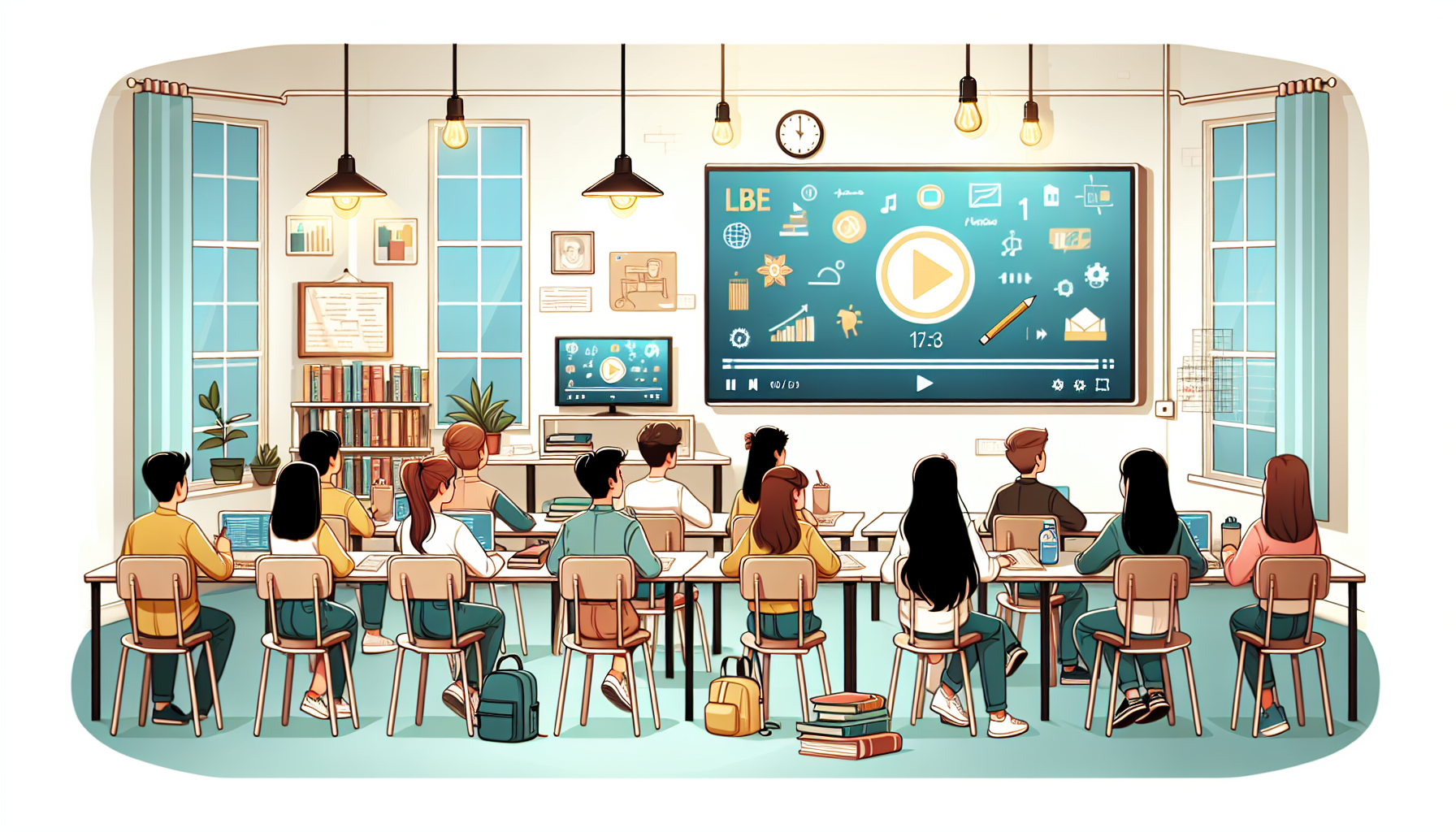It’s totally understandable to feel like student engagement is a tough nut to crack. Sometimes, traditional teaching methods just don’t cut it, leaving students zoning out or losing interest. If you’ve ever wished for a magic formula to keep those youthful minds intrigued, you’re definitely not alone!
Well, you’re in luck! If you stick around, I’ll share how videos can revolutionize your approach and capture your students’ attention like nothing else. This isn’t just about tossing in a cool YouTube clip—trust me, there’s so much more you can do with video to really connect and inspire.
We’ll dive into a variety of video types, explore their awesome benefits, and discuss best practices to make your videos truly shine. Plus, I’ll give some tips on how to weave them seamlessly into your lesson plans and measure their impact—because who doesn’t love a good success story?
Key Takeaways
- Video enhances student engagement by making learning dynamic and visually appealing.
- Different types of videos—like instructional, testimonial, and live-streamed sessions—cater to various learning styles.
- Students can learn at their own pace, allowing for better comprehension and retention.
- Effective educational videos should be concise, visually engaging, and accessible to all learners.
- Integrate videos into lesson plans to bolster interest and understanding; follow up with discussions or activities.
- Measure the impact of video through student feedback and performance assessments to continually refine your approach.

How Video Boosts Student Engagement
Video can significantly enhance student engagement by providing dynamic and visually appealing content.
When students watch videos, they often find it easier to comprehend complex topics as visual aids can clarify concepts that text alone might not convey.
Moreover, the inclusion of video allows for different learning styles—whether it’s visual, auditory, or kinesthetic—thus catering to a wider range of students.
For example, incorporating short clips during lectures or using them as a pre-class assignment can spark interest and enhance retention.
Additionally, video can create a more interactive learning environment, allowing students to participate actively through questions or discussions based on what they have viewed.
Types of Videos to Use in Education
There are several types of videos educators can utilize to promote student engagement.
Instructional videos are perhaps the most common, providing explanations and demonstrations of key concepts.
Another popular type is testimonial videos, which can feature former students sharing their success stories, fostering a sense of community and motivation.
Even short films or animations can be effective in illustrating challenging subjects and making them more relatable.
Live-streamed lessons or Q&A sessions can also give students real-time access to their instructors, enhancing the learning experience.
For a boost in interactivity, consider utilizing video quizzes, which can assess students’ understanding while keeping them engaged.
Benefits of Using Video for Student Engagement
Using video in education comes with a range of benefits that can lead to improved student outcomes.
Firstly, videos are often more engaging than traditional lecture formats, keeping students focused and interested.
They provide the opportunity for students to learn at their own pace—pausing or rewatching sections as needed, which can boost comprehension.
Furthermore, video content can enhance communication by allowing students to see and hear their instructors, thereby creating a personal connection.
Another advantage is the accessibility of video materials for students who may struggle with reading or writing.
Not to forget, the use of videos can save time during class, allowing educators to cover more ground in a shorter period while giving students a resource to refer back to later.
Best Practices for Creating Educational Videos
Creating effective educational videos involves more than just filming yourself talking at the camera.
Start by keeping videos concise; aim for a length of 5-10 minutes to maintain attention spans.
Always plan your content ahead of time, using a script or outline to ensure clear delivery of key points.
Incorporate visuals like slides or animations to support your message, and consider editing to enhance engagement. Tools such as Canva and Camtasia can be great for making eye-catching graphics.
Additionally, consider adding captions or subtitles to make your videos accessible to all students.
Finally, remember to test your video on different devices to ensure it’s compatible with various platforms your students may use.

Implementing Video into Lesson Plans
Integrating video into lesson plans can elevate the overall learning experience and spark student interest.
Start by selecting relevant videos that align with your lesson objectives; this way, students see the value of the material firsthand.
For instance, you might introduce a topic with a compelling documentary clip that sets the stage for a deeper discussion.
You can also break your lesson into segments, using videos to supplement each part, helping to reinforce key concepts.
Don’t forget to include time for discussion or activities following video segments; this allows students to process the information and engage more deeply.
Lastly, consider assigning videos as homework, ensuring that students come prepared to explore the material further in class.
Measuring the Impact of Video on Engagement
To see if video is making a difference, it’s essential to measure its impact on student engagement effectively.
Start by gathering feedback from students about their experience with the videos—simple surveys or informal discussions can work wonders.
Tracking participation during video-based lessons can also provide insight; are more students asking questions or participating in discussions?
Another useful method is to compare students’ performance before and after integrating videos into your lessons.
Consider using pre- and post-assessments that gauge understanding of key concepts discussed in videos.
This data can help highlight what’s working and what needs tweaking, ensuring you’re always improving your approach.

Overcoming Challenges with Video in the Classroom
Implementing video in the classroom isn’t without its hurdles, but many can be tackled with some preparation and creativity.
A common issue is the technological barrier; not every student may have reliable internet access or modern devices.
To mitigate this, provide downloads of essential videos for offline viewing, or consider adapting your materials to be consumable on lower-bandwidth devices.
Another challenge is ensuring that video content complements rather than overwhelms the lesson.
To overcome this, keep videos concise and clearly related to your learning objectives, guiding students on how each video ties into the bigger picture.
Lastly, be mindful of potential distractions during video viewing; students may be tempted to multitask.
To address this, create structured activities or guided viewing questions to ensure they stay focused and engaged throughout the video.
Tools and Resources for Creating Engaging Videos
When it comes to creating educational videos, the right tools can make all the difference.
For high-quality recordings, consider using platforms like Zoom for live sessions or OBS Studio for pre-recorded content.
If you’re looking to edit your videos, tools like Adobe Premiere Pro and iMovie can help put the finishing touches on your footage.
For those who want to create eye-catching graphics, platforms like Canva and Snappa are user-friendly resources that provide templates and design elements.
Additionally, if you’re considering animated content, try using software like Animaker or Vyond to create engaging animated videos that can simplify complex information.
Lastly, don’t overlook the power of stock footage; sites like Pexels and Videvo offer free resources that can enhance your videos without breaking the bank.
FAQs
Video enhances student engagement by providing dynamic visual content that captures attention, facilitates discussion, and fosters active learning. It caters to diverse learning styles and encourages participation, thus improving overall classroom involvement.
Best types of videos for education include instructional videos, animated explainers, interviews with experts, and real-life simulations. These formats effectively convey information and stimulate interest among students.
Key benefits of using video in education include enhanced retention of information, increased motivation to learn, the ability to revisit complex topics, and providing a collaborative learning environment through shared content.
Best practices for creating educational videos include keeping content concise, using clear visuals, incorporating engaging storytelling, and ensuring high audio quality. Regularly seeking feedback can also refine your approach.
